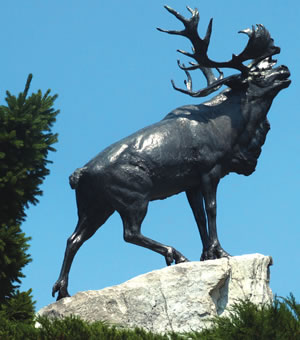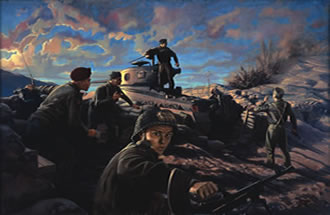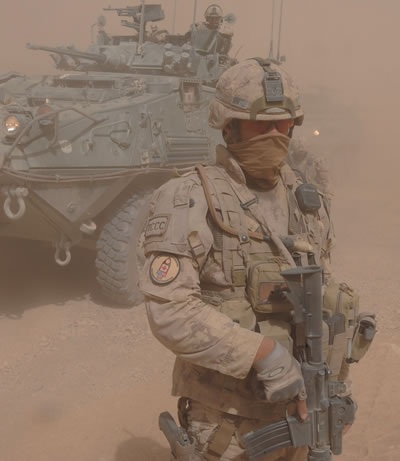Canada Remembers Times - 2011 Edition - Page 1
Download the PDF Version.
PDF Version 1.41 MB
The Black Pit

Consolidated VLR Liberator provides air cover for a transatlantic convoy.
Library and Archives Canada PA-107907
Many of the vehicles, weapons and ammunition needed by the western Allies to fight Germany during the Second World War were made in North America. The Merchant Navy transporting these critical supplies across the Atlantic had to evade hundreds of enemy submarines, called U-boats. If Germany could cut this supply route, it would win the war.
U-boats were hard to find in the vast ocean and Allied convoys often consisted of dozens of merchant ships protected by just a handful of armed naval escorts.
Early in the war, a portion of the mid-Atlantic was out of range to most aircraft. This area was particularly dangerous and came to be known as “the Black Pit.” When convoy SC 107 sailed from Sydney, Nova Scotia, to England in the fall of 1942, 17 U-boats converged on the 42-ship convoy, sinking a total of 15 ships.
By mid-1943, technological advances like long-range aircraft helped turn the tide in the Battle of the Atlantic. Courageous Canadians helped keep the supplies flowing when they were needed most.
Newfoundlanders at Beaumont-Hamel

The Beaumont-Hamel Newfoundland Memorial in France.
Veterans Affairs Canada
July 1st is known as Canada Day, but in Newfoundland and Labrador it has an additional and more sombre meaning. There, it is also known as Memorial Day—a time to remember those who gave so much in the cause of peace and freedom.
On this day in 1916, approximately 800 men from the 1st Newfoundland Regiment went forward into a thick hail of enemy fire on the first day of the First World War’s Battle of the Somme. They tucked their chins in as they walked through the bullets and shrapnel, as if they were walking through a snowstorm. In less than half an hour, the Regiment was torn apart. The next morning, only 68 were able to answer the roll call. It was a day that would never be forgotten in Newfoundland.
However, the Newfoundlanders would rebuild the Regiment and go on to earn the name Royal Newfoundland Regiment for their brave actions in battles during the war.
Today, the Beaumont-Hamel Newfoundland Memorial overlooks the old battlefield. This site commemorates all Newfoundlanders who fought in the Great War, particularly those who have no known grave.
Korea’s “Little Gibraltar”

The war painting Incoming by Edward Zuber depicts
Canadians under attack on Hill 355.
CWM 19890328-008. Beaverbrook Collection of War Art.
©Canadian War Museum
More than 26,000 Canadians served with United Nations (UN) forces in the Korean War between 1950 and 1953. Korea’s rugged terrain made it a hard place to fight. Hill 355—nicknamed “Little Gibraltar”—was the highest hill for kilometres around and that made it important to have. The hill had been the scene of several fierce battles, and in October 1952, Canadian soldiers there found themselves fighting for their lives.
For days the Chinese heavily bombarded the Canadians defending the hill to smash their positions. Then, on the evening of October 23, the Chinese launched an all-out assault. The Royal Canadian Regiment was hit hard by wave after wave of enemy soldiers and one company was forced to fall back. The outnumbered Canadians had to hunker down in their trenches and request supporting artillery fire as the Chinese swarmed over the hillside. A counter-attack was then ordered to retake the lost ground. It was hard fighting and the Royal Canadian Regiment took heavy losses—18 killed, 35 wounded and 14 captured—but they had held out against the odds.
Canada’s Engagement in Afghanistan

Canadian Forces member providing security at a landing zone
in Kandahar. July 2010.
Department of National Defence AR2010-0177-28
The combat aspect of the Canadian Forces’ efforts in Afghanistan is scheduled to end in 2011. The origins of Canada’s involvement there go back to September 11, 2001 when al-Qaeda terrorists highjacked four American airliners and attacked the World Trade Center and the Pentagon, killing almost 3,000 people. Afghanistan, which was governed by the extremist Taliban regime who had harboured al-Qaeda, was quickly targeted for an international military response.
Canada’s first contribution to the war on terror came at sea as our warships joined a fleet patrolling the waters off the region. Canadian soldiers’ boots hit the ground in Afghanistan soon after as they joined the American and British forces who were already fighting there. Our air force has also played an important role, by conducting patrols at sea and providing transport support to the coalition forces.
Over the past decade, Canadian soldiers have primarily been based in the capital city of Kabul and in the southern province of Kandahar. Their roles have been varied, from engaging in large-scale military operations to patrolling remote areas, helping to improve infrastructure, and providing humanitarian aid. These efforts have come at a great cost, as more than 150 Canadians have lost their lives in trying to establish a lasting peace.
While Canada’s role in Afghanistan has sparked debate, the accomplishments and sacrifices of Canadian Forces members in the country have helped foster a renewed national pride for our men and women in uniform. From ‘Red Fridays’ to the crowds that line the ‘Highway of Heroes’ when fallen soldiers return home, their efforts have not been forgotten.
Taking Courcelette

War painting The Capture of the Sugar Refinery at Courcelette by the
Canadians on September 15, 1916 by Fortunino Matania.
CWM 19870268-001. Beaverbrook Collection of War Art.
©Canadian War Museum
One of the bloodiest chapters of the First World War was the Battle of the Somme, which raged in northern France in the summer and fall of 1916. The Canadian Corps’ first major action began on September 15 in the offensive on the village of Courcelette.
The soldiers advanced behind a creeping barrage, a new tactic that saw attackers closely follow a line of artillery fire that moved forward on a carefully timed schedule. Tanks were also used—the first time these new weapons ever appeared on a battlefield. The main objective, a position known as the “Sugar Factory,” was soon taken. The Canadians then pushed ahead to Courcelette, with the French-Canadian 22e Bataillon playing an important role in taking the village.
In the weeks that followed, the Canadians attacked and captured a number of enemy positions. The Battle of the Somme cost our country more than 24,000 casualties, but the Canadians’ achievements confirmed their growing reputation as some of the best soldiers on the Western Front. Canada has a special memorial in Courcelette to commemorate those who fought there.
Learn more about Canada’s war memorials- Date modified: